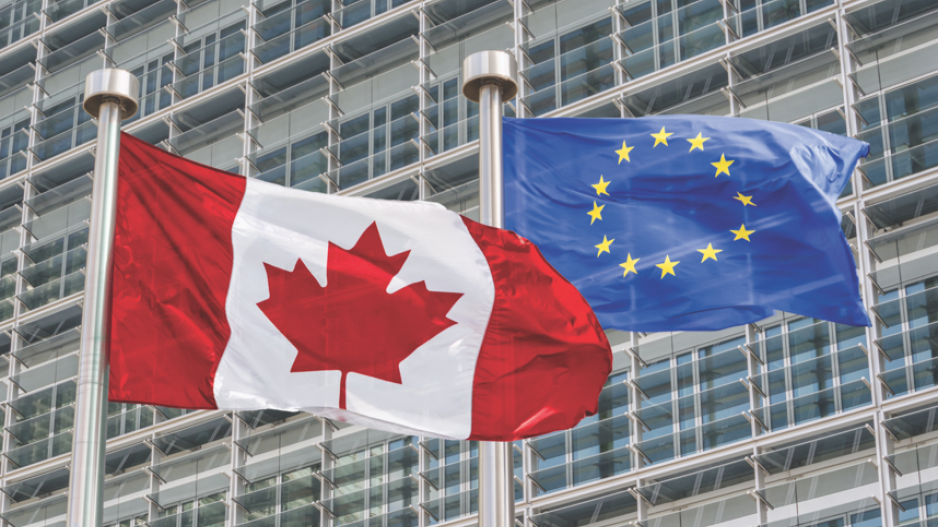Canada's fast-approaching free trade agreement with Europe is a golden opportunity to invigorate B.C.’s manufacturing, technology and other value-added sectors – but only if local companies learn to convey concrete benefits to potential European customers.
That’s the message from lawyers heavily involved in international trade circles who spoke in Vancouver recently to galvanize B.C. business in the face of the Comprehensive Economic and Trade Agreement (CETA) between Canada and the European Union.
The deal, which comes into effect on September 21, differs from other free trade deals like the North American Free Trade Agreement (NAFTA) because most of the tariff barriers CETA will remove will disappear immediately.
NAFTA and other free trade deals have had phase-in periods for tariff reduction that took years to lower rates to the final intended target.
Didier Culat, an international business lawyer with BCF, was one of the speakers at a September 12 University of British Columbia (UBC) event hosted by the federal Ministry of International Trade. The presentation, which targeted B.C.’s medical-device makers, was meant to outline how CETA’s instant tariff change could be a boon for companies willing to invest time and money into a marketplace of 512 million people.
“The instant drop in tariffs means an instant change in concrete costs for a European customer buying Canadian goods in certain sectors, which brings a big visibility boost [for Canadian products],” Culat said. “What B.C. businesses need to do is to change the semantics when talking to Europe. We need to start talking about landed costs.”
Culat noted that most European buyers, when getting cost estimates from international suppliers, ask for factory pricing that does not include additional costs to get a product into a buyer’s inventory. That “landed cost” includes shipping, tariffs and a buyer’s ability to use new inventory to leverage credit.
When all those items are taken into account, a B.C. product shipped through Halifax – which would reach Rotterdam, Europe’s largest port, nine days quicker than if shipped through New York – would have a significant cost advantage compared with an American competitor from the Pacific Northwest.
“There are not FTA [free trade agreement] negotiations between Europe and the United States right now, and there are none in the foreseeable future,” Culat said. “Even if they started today, CETA took seven years to complete, so Canada would have an advantage for a long time.”
He added that he targeted B.C.’s medical-device makers in the UBC event because it’s one of the sectors most ready for an immediate uptake in Europe. Currently, the $56 billion European market for imported medical devices is dominated by the U.S. (43.3% market share) and China (14.4%), but both have to pay tariffs of up to 8%.
Canada, whose EU tariff will disappear on September 21, currently has a mere 1% of that market. Even an increase of one percentage point, Culat said, would inject millions into the Canadian economy.
“I would think that a device made in Burnaby would be just as good, if not better than, a similar device made in Guangzhou,” he said. “And when you talk about the landed cost to clients, the advantage is obvious.”
Bruce Harwood, an immigration lawyer with Boughton Law in Vancouver, added that CETA includes some provisions that – theoretically – would improve labour mobility for research workers from Europe to B.C., resolving the labour crunch in the local technology sector. But given that Ottawa has not yet provided detailed guidelines of who would qualify, the impact is unclear.
“CETA has the potential to make things smoother in finding European candidates in certain sectors,” Harwood said. “But first, we need a manual of working rules under CETA from the Canadian government agencies.”
One Lower Mainland municipality that appears to have already taken notice is Richmond, whose chamber of commerce will be hosting a September 27 CETA business forum along with the EU Chamber of Commerce in Canada West at the city’s Executive Airport Plaza Hotel. The meeting will focus on agri-food and clean-tech sectors, and organizers noted businesses can’t lose sight of the fact that a flight from Vancouver to London is approximately 10 hours – about the same as a flight to Tokyo.
“Europe is not a remote destination, though it may feel that way to some,” said Richmond Chamber of Commerce president and CEO Matt Pitcairn. “Richmond is definitely Canada’s gateway to the Asian market. … However, the EU has never been an insignificant trading partner – currently, the EU is B.C.’s fourth-largest trading partner. So this is why we’re so pleased to be able to bring together our local business leaders with the dignitaries from the EU’s 28 member nations, because we often find that the best opportunities arise out of conversation.”
According to Statistics Canada, only two European markets – Great Britain (seventh) and the Netherlands (10th) – ranked among B.C.’s largest export destinations in 2016, accounting for $410 million and $243 million, respectively.
For Canada, four European markets made the top 10 in 2016, including Great Britain (third, $16.3 billion), Germany (eighth, $3.5 billion), Belgium (ninth, $3.1 billion) and France (10th, $3 billion).
For B.C. exports, manufactured goods such as machinery or medical instruments continue to lag behind minerals, base metals, lumber and wood pulp as key exports, currently making up only 8.4% of the province’s total merchandise exports. •




